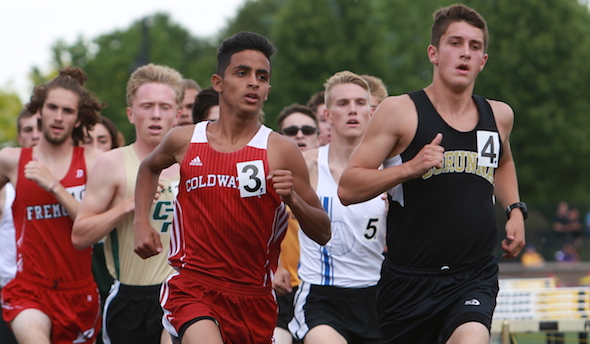
Corunna Star Recovers to Shine Again
By
Tom Markowski
Special for Second Half
June 3, 2017
ZEELAND – Noah Jacobs of Corunna is another in a long line of tremendous distance runners to come out of this state.
Among the names he’s chased include Olympian Dathan Ritzenhein of Rockford and Grant Fisher of Grand Blanc.
Jacobs, a senior headed for University of Wisconsin, was the two-time defending Lower Peninsula Division 2 Finals champion in the 3,200-meter run and last year he added the New Balance two-mile national championship.
This past fall Jacobs won the Division 2 cross country championship with a time of 15:28.00.
Unbeknownst to him, this year would be different. Challenges always present themselves, but Jacobs was shaken by what he had to face as he began to prepare for the 2017 track & field season.
In February, Jacobs was diagnosed with a stress reaction in his left tibia. A stress fracture is more severe. Fortunately for Jacobs, the injury stopped just short of a fracture.
Still, for five weeks he had to shelve his training and deal with the mental anguish of knowing it would be a long, painstaking road back to the MHSAA Finals, if indeed he could return.
A few weeks ago, Jacobs noticed his times were getting back to where they were a year ago. On Saturday, he fought off fierce competition and defended his LP Division 2 Finals titles in the 3,200 (9:11.63) and added a first-place finish in the 1,600 run with a time of 4:14.03 at Zeeland East to complete was has been a courageous comeback.
“Last season I was blessed with great health,” Jacobs said. “This year I was battling. I was losing races, to some good runners. I didn’t have that same kick. I had to break that mental barrier.
“(In February) I was a mental wreck. My teammates and my family kept me going.
“It was around Regional time, in early May, I was running in two or three quality meets. I kind of got my routine back. I got to use the race situations I used to use. The last two weeks have really been good. (My leg) is not perfect. People asked me how it is, and I have one word for them – ready. I’m ready.”
Jacobs had to fend off a couple runners coming into the second-to-last turn to win the 1,600.
“I took the lead with about 250 meters left,” he said. “I knew they wanted it. It could have been a tenth of a second, it could have been five seconds. I don’t know.”
His win in the 3,200 held more drama. He led with 600 meters to go before Shuaib Aljabaly of Coldwater put forth a burst of speed to pass Jacobs by two meters.
“I knew that I had to draft (early in the race),” Jacobs said. “I’ve raced (Aljabaly) before. I didn’t worry about him running. I just had to attack the last half. I had to push and push and push.
“I had a couple of coaches with 100 meters to go screaming at me. When he took the lead, I had to fight, fight. It’s happened before.”
Jacobs overtook Aljabaly with 50 meters left and won by 21 hundredths of a second.
Home cooking
One thing that can top winning an MHSAA Finals title is winning one at home.
Zeeland East won its first boys track & field team title with a score of 71 points. Coldwater placed second with 42.
East had clinched its 1,600 relay team took first as well.
Coach Ralph Neal, in his seventh season, said everything went right for his team.
“It was an amazing day,” he said. “I can look back at two years ago and what we were trying to build. I saw enough talent. I saw the field events. I saw the relays. We had all these pieces that came together. Nothing went wrong today. It’s what a coach dreams about.
“It is special winning it at home. (Athletic director) Tim Ritsema pulls his hair out to get this (event) going.”
Junior Brenden Knoll placed second in both the discus (176 feet, 7 inches) and shot put (55 feet) to earn his team 16 points. He said the formula to winning was basic.
“We put in the work, every day,” he said. “I just had my mind right. I put everything else aside. It feels real good. These are the reasons you work so hard.”
Getting serious pays off
John Adams III of Ferndale never qualified for the MHSAA Finals until this year. Last year he started running track for the first time, to stay in shape for football. That reasoning paid off as Adams, a 5-foot-10, 160-pound slot back and defensive back, will attend Olivet College in the fall with every intention of competing for a starting spot on the football team.
Fearless, Adams competed in the 100 dash, and he certainly wasn’t one of the favorites. That didn’t bother him. With a time of 10.94, Adams placed first in the 100.
“I won because I worked the hardest,” he said. “I didn’t take track seriously until this year. When I got beat in the (Oakland Activities Association) meet (May 11), that’s when it hit me. I finished third. It was hand-held time, and it was really close. I’m not sure anyone knew who won. I didn’t want that to happen again.”
Special days
Sunday is Noah Caudry’s 18th birthday. It’s likely he’ll remember the day before his 18th birthday better in the years to come.
Caudry of Lake Odessa Lakewood won the 110 and 300 hurdles, and helped his team place fifth in the 400 relay even though it didn’t compete in the fast heat.
His time in the 110 (14.05) was a personal best. He’s a three-time champion in that event.
“This is my specialty,” he said of the 110. “I was hoping for (the three consecutive titles). I was hoping to get in the 13s, but I’ll take a PR.”
Caudry is a remarkable person. He graduated with a 3.94 grade-point average and plans on entering optometry school after earning a degree in biology.
New event, new success
Junior Cameron Oleen was a half-miler since he began running track at Fruitport two years ago.
This season, it was suggested Oleen run the 400 dash. He’d never run it before but thought he’d give it a shot.
“I really like it,” he said. “It’s the most difficult race. I can pace myself in the 800. In the 400 you have to run as fast as you can all the way through it. You could pace yourself in the first 300 meters and then die in the last 100. You might as well run as fast as you can the first 300.”
It would be difficult to argue that point with Oleen. He won the 400 with a time of 49.21 seconds.
“It’s conditioning,” he said. “The 800 helps me train for the 400.”
Oleen also competes in cross country and basketball. He added that running cross country helps him maintain the proper conditioning for the other two sports.
PHOTO: Corunna's Noah Jacobs, far right, stays a step ahead of Coldwater's Shuaib Aljabaly during Saturday's 3,200 at Zeeland. (Photo by Janina Pollatz/RunMichigan.com.)
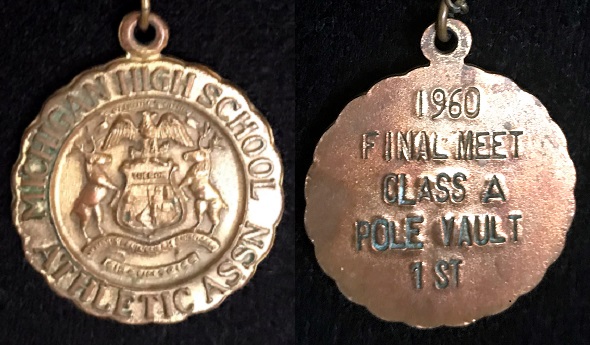
60 Years Later, Co-Champ Rediscovered
March 25, 2020
By Ron Pesch
Special for Second Half
Nicholas “Mickey” Turcheck tells a wild story. It involves a coin flip.
Involved in track & field for much of his life, Turcheck was a pole vaulter at Taylor Center during his high school days, then at Western Michigan University. He later served Taylor Center for more than three decades as track coach, where he mentored five state champions.
He also coached two future Olympians. Earl Jones, who won MHSAA Finals track titles in both 1980 and 1981, and grabbed bronze in the 800 meters at the 1984 Summer Olympics in Los Angeles. Another of his athletes, Deby LaPlante, qualified for the 1976 Summer Olympics in Montreal as a high hurdler.
In Turcheck’s possession is a medal. Etched on the back, pounded out in the style of the time, are five lines.
1960
FINAL MEET
CLASS A
POLE VAULT
1ST
Those 31 characters honor his MHSAA championship performance on what became a windy day in Ann Arbor at University of Michigan’s old Ferry Field.
But there is one problem. Turcheck’s name doesn’t appear on the MHSAA list of Finals champions. According to the list, the championship belongs to Joe Baldy of Monroe.
(The list has since been corrected and amended, per the story to be told below.)
Trackheads
For ‘trackheads’ – diehard fans of the sport and the events that comprise a track meet – as well as sports historians, a newspaper’s agate page is nirvana. Contained within the tiny type are the details that aren’t always relayed within the article covering a sporting event. Things like baseball batting averages, league standings, box scores, stat lines, team transactions, TV and radio schedules, and most everything else that doesn’t fix conveniently into the day’s sports section might appear on the page. For a track meet, a full agate listing will include place finishes as well as times, heights and distances that were used to determine winners of events, as well as detail on record performances that were equaled or topped.
Jim Moyes is a passionate sports fan. An undersized high school athlete at a small school, where participants of all shapes and sizes are valued, Moyes was the son of a prep coach at North Muskegon High School. He grew up and became, among other things, a beloved and respected broadcaster and public address announcer. Few were as well-prepared as Moyes, who studied agate pages, past performances, and, it seemed, the family trees of the participants prior to sitting before a microphone. His knowledge, as well as his sense of humor, was on display for 43 years in West Michigan, where he would balance his understanding and importance of an event with the awareness that, in the end, what we were experiencing was still just a game.
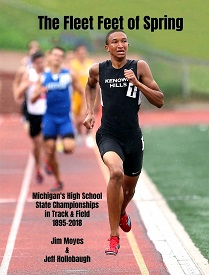 Well over 30 years ago he began his research into a passion project. Moyes is a ‘trackhead.’ And, because of this, in 2019, he officially became the author of a published book.
Well over 30 years ago he began his research into a passion project. Moyes is a ‘trackhead.’ And, because of this, in 2019, he officially became the author of a published book.
Way back, Moyes began digging into microfilm with the goal of capturing the names and events behind each MHSAA Finals track championship. He shared his initial research with the MHSAA, and for years the Association has highlighted his work on its website with lists of individual state champions on both their boys and girls track pages.
A couple of years before wrapping up his research, Moyes began work with another certified ‘trackhead,’ Jeff Hollobaugh – associated editor of Track & Field News, the voice of countless track meets, and as Moyes states, an “expert on this great sport” – to tell the stories of the meets in book form. “The Fleet Feet of Spring” – a history of Michigan’s High School State Championships covering the span 1895-2018 – was the result.
That’s 24,446 state champions. Simply put, its 439 pages contain a marvelous collection of statistics, stories and images.
But, with good reason, Turcheck’s name doesn’t appear in the publication.
Golden Age of Newspapers
Post-event press coverage on the 1960 MHSAA State Track Meet for most readers across Michigan arrived in their newspaper courtesy of coverage by wire-service reporters from The Associated Press or United Press International. With four meets to cover that encompass hundreds of prep athletes, the arch of the stories generally focus on record-setting events and streaks of success.
In Class A, the story was focused on the Pontiac Central squad that slipped past Flint Northern, 44-41, for its fifth title in six years. It was the seventh year in a row that the Vikings finished second at the meet. Pontiac junior Bredell Pritchett’s 59-foot-5¾ toss of the shot exceeded the previous state mark by better than two feet. Northern’s Maurice Pea, clocked at 9.8 seconds, tied a 35-year-old mark in the 100-yard dash. Al Ammerman of Dearborn established a new high jump record.
In 1960, the details of the pole vault simply weren’t the story.
Available space in newspapers is dictated by advertising. That certainly is the case today, and was most certainly the case back in the glory days of newsprint. Decisions are made by sports editors and staff on the amount of space available, and what agate will be printed. The results of a track meet, let alone the four simultaneous meets that comprise the MHSAA state championships, can certainly eat up plenty of real estate.
Relatively few papers around Michigan dedicated space to the MHSAA Track Championships back in May 1960. The old Detroit Times is among those that did include agate. Study of the listing however provides little clarity, as the paper listed only Metro Detroit finishers beyond the event winners. For the pole vault, that means confusion.
Pole Vault – “1 Joe Baldy, Monroe: Mickey Turcheck. Taylor Center: Bob Davis. Redford Union. and Larry Richardson. Livonia Bentley. were among those tieing for fourth. Distance 12 feet, 9 inches.”
The Grand Rapids Press agate adds haze to the mix. Baldy is listed in first, but Turcheck is listed as finishing second, followed by Flint Northern’s Jerry Wright in third. Davis, Richardson, Mike Pedler of Muskegon, J. Best from Battle Creek Central and Bill King of Traverse City are listed as occupying fourth place
The Battle Creek Enquirer lists only Baldy as the winner of the event and John Best “tied for fourth.” The Lansing State Journal agate shows only Baldy as the event winner. No track agate appears in the Detroit Free Press. Although the paper notes that team-wise, Birmingham finished third with 18 points, followed by Dearborn, Ann Arbor, Muskegon and Saginaw Arthur Hill in its coverage, the results from the Class A pole vault are not mentioned.
The Traverse City Record-Eagle does not include agate, but the article notes King’s fourth place finish, and that the Trojans track team spent the night sleeping on tumbling mats in the Saginaw Arthur Hill gymnasium when its bus broke down on the return trip home from Ann Arbor.
So, with little surprise, Moyes’ research concluded Baldy was the 1960 Class A pole vault champion.
Story of the Medal
In early March, Tony Mifsud, a longtime track coach at Dearborn Divine Child, contacted MHSAA Director of Broadcast Properties John Johnson about the story.
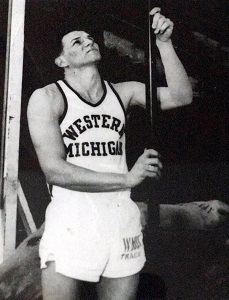
Turcheck was recently visiting a friend, Bob Parks, the head track coach at Eastern Michigan University for 34 years and an assistant track coach at Western Michigan during Turcheck’s time in Kalamazoo competing for the Broncos. On a visit this past fall, Parks mentioned the Moyes and Hollobaugh book that he had recently received.
“Mick, your name is not listed there,” said Parks. “I know you were tied for the state championship because I was the coach at Redford Thurston at that time and I was at the state meet. I remember you being announced as the co-state champion of the pole vault.”
“I said, ‘Really?’” recalled Turcheck from his home in Taylor.
After the visit, he made a couple of phone calls to friends. In turn, some of those folks began reaching out to others with the story.
According to Turcheck, after the pole vault was over, a meet official said they only had one medal and they were going to flip to determine who would receive it. Turcheck won the coin flip and was awarded the souvenir. A duplicate medal was to be mailed to his co-champion.
Newsprint and the Miracle of Microfilm
Before the days of smartphones, e-mail, websites, pop-up ads, and cloud storage, the history of cities, big and small, was captured in print and sold on street corners, at newsstands, and, beginning in 1947, by coin-operated vending machines.
Monthly subscriptions meant home delivery of the day’s news, and newspapers were everywhere.
Before Craigslist and Google Ads, there was money to be made in helping businesses advertise their wares, employers to advertise job openings, and for individuals to sell items and offer apartments for rent in the classifieds. That strong revenue stream supported large staffs and solid coverage of local events at daily and weekly newspapers.
Some of that content – that history – is slowly coming online, but most of it remains tucked away on microfilm and microfiche in local libraries across America.
And sometimes, local pride resulted in details about the exploits and accomplishments of area athletes to appear in smaller town publications that cannot be found elsewhere.
Niles Kruger, a sportswriter at the Monroe Evening News, followed up on a request by Johnson to check microfilm from newspapers in the area for any detail that might exist. Fortunately, the coverage in the Evening News appears to help clear up much of the story.
The article also illustrates an issue often injected upon microfilm by small agate-style typeface. Characters can often bleed or blur and appear to be other letters. A lower case ‘s’ can look like an ‘a’ or an ‘e’; a lower case ‘i’ can look like lower case ‘l.’ Unexpectedly, this, too, was illustrated here.
And sometimes, long lists are subject to other errors.
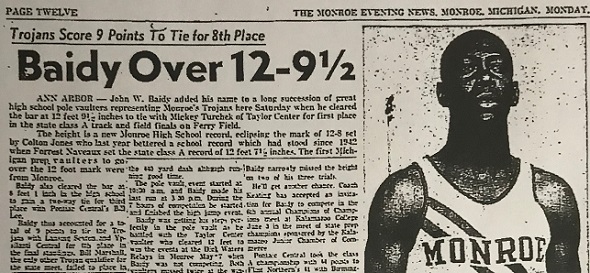
‘Baidy’ not ‘Baldy, ‘John’, not ‘Joe’
“ANN ARBOR - John W. Baidy added his name to a long succession of great high school pole vaulters representing Monroe’s Trojans here Saturday,” stated the Evening News, “when he cleared the bar at 12 feet 9 ½ inches to tie with Mickey Turcheck of Taylor Center for first place in the state Class A track and field finals on Ferry Field …”
“Baidy also cleared the bar at 6 feet 1 inch in the high (jump) to gain a two-way tie for third place with Pontiac Central’s Bill Lee. Baidy thus accounted for a total of 9 points to tie the Trojans with Lansing Sexton and Ypsilanti Central for 8th place in the final standings.”
While there is no mention of the flip for the metal, the article backs up Turcheck’s recall of the day.
Recognizing that despite their best efforts, Moyes and Hollobaugh know that errors can appear in the publication. In their “Notes to the reader” section, they ask readers to please make contact if any mistakes are spotted.
“Thanks to today's modern technology Jeff Hollobaugh will be able to make the appropriate corrections in our book” noted Moyes from Florida via email, noting the marvels of the times we live in. “Better yet for Jeff & I,” added Moyes, displaying his comedic style, “with the amended corrections maybe Mickey Turcheck will purchase our newly revised book.”
Search for Baidy
“They wanted to flip a coin,” said Baidy recently, surprised in the sudden interest in a day from so many years ago and chuckling at the memory. “He got the call and got the medal. I really don’t remember if they told me if I was supposed to get a medal (in the mail). Right after that I had to go to the high jump or something.”
Baidy – who also tied for the Class A Finals high jump championship in 1959 – had received a call earlier on this day from his long-ago opponent from Taylor Center.
“I would certainly like to meet him again,” said Turcheck. His former high school sweetheart and bride had used her smartphone to seek out Baidy’s contact information, and soon after, the two old athletes were reminiscing about the day. Turcheck pitched the idea of getting together for lunch or dinner sometime soon.
“That’s what he wants to do, and it’s all right with me,” Baidy said, noting plans after things settle down. “We’re lucky to still be alive.”
 Ron Pesch has taken an active role in researching the history of MHSAA events since 1985 and began writing for MHSAA Finals programs in 1986, adding additional features and "flashbacks" in 1992. He inherited the title of MHSAA historian from the late Dick Kishpaugh following the 1993-94 school year, and resides in Muskegon. Contact him at [email protected]:void(0);t with ideas for historical articles.
Ron Pesch has taken an active role in researching the history of MHSAA events since 1985 and began writing for MHSAA Finals programs in 1986, adding additional features and "flashbacks" in 1992. He inherited the title of MHSAA historian from the late Dick Kishpaugh following the 1993-94 school year, and resides in Muskegon. Contact him at [email protected]:void(0);t with ideas for historical articles.
PHOTOS: (Top) The 1960 Finals championship medal, front and back, awarded to Baidy. (2) The Fleet Feet of Spring has been revised based on the latest re-discovery of a co-championship. (3) Mickey Turchek went on to compete at Western Michigan. (4) The Monroe Evening News announced John Baidy’s championship pole vault as part of its coverage of the 1960 Class A Track & Field Finals. (Turchek photo courtesy of the Turcheck famly; newspaper clipping courtesy of the Monroe Evening News.)

